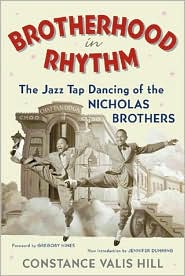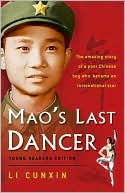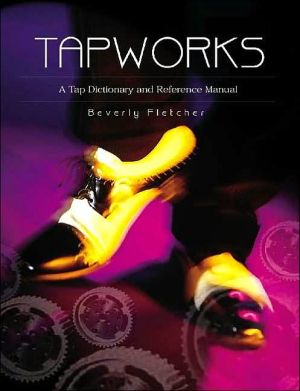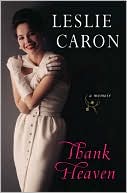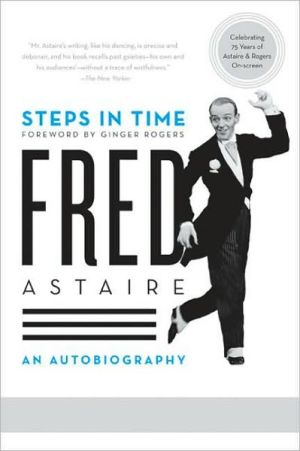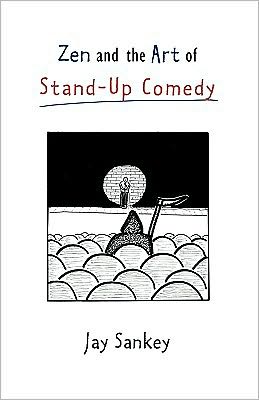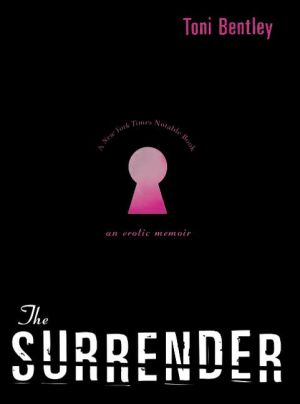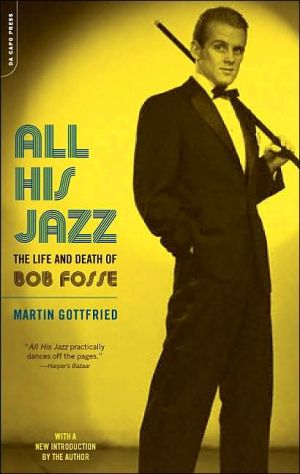Brotherhood in Rhythm: The Jazz Tap Dancing of the Nicholas Brothers
Tap dancing legends Fayard (b. 1914) and Harold (1918-2000) Nicholas amazed crowds with their performances in musicals and films from the 30s to the 80s. They performed with Gene Kelly in The Pirate, with Cab Calloway in Stormy Weather, with Dorothy Dandridge (Harold's wife) in Sun Valley Serenade, and with a number of other stars on the stage and on the screen. Author Hill not only guides readers through the brothers' showstopping successes and the repressive times in which their dancing won...
Search in google:
Brotherhood in Rhythm tells the story of their personal and professional triumphs; their legendary gigs with Duke Ellington and Cab Calloway; their struggles with racism; and their performances in such classic movies as Stormy Weather, Down Argentina Way, Orchestra Wives, and Sun Valley Serenade. Library Journal This is a lovingly researched and thoughtfully created portrait of Fayard and Harold Nicholas, whose spectacular dance routines have captivated stage and screen audiences from the Depression era to current times. Hill's infectious admiration will inspire even those not well acquainted with the pair to locate Down Argentine Way or Sun Valley Serenade and enjoy their performances. In his introduction, Gregory Hines praises the one-of-a-kind routines the brothers developed, which included intricate steps, breathtaking splits, and impeccable timing. Their style was outstanding, but so was their highly professional approach to the mercurial world of show business, with its particularly disturbing racial issues. Exceptionally clear and useful descriptions of the elements of early jazz, the evolution of the minstrel show, and the components of various dance forms provide background on the forces influencing the performance world of the time. A natural for dance enthusiasts, this is also essential reading for anyone interested in entertainment history.--Carol J. Binkowski, Bloomfield, NJ Copyright 2000 Cahners Business Information.\\
\ \ \ \ \ Chapter One\ Born\ into Jazz\ \ \ Fayard Nicholas was born in Mobile, Alabama, on October 28, 1914, twelve weeks after the Austro-Hungarian declaration of war on Serbia and amidst the succession of declarations of war by other European countries that exploded into World War I. Harold Nicholas was born in Winston-Salem, North Carolina, on March 17, 1921, in the wake of the Great War. In Paris a year before Fayard's birth, Igor Stravinsky's dissonant and pulsating score for the Ballets Russes' Le Sacre du printemps had instigated outraged members of the audience to stomp their feet and beat each other over the head, their strokes synchronized with the beat of the music. Their response to the rhythm-driven syncopations in Stravinsky's jazz-influenced score echoed the volatile predisposition of a people on the brink of war. In the span of time between the Nicholas brothers' births, with its mixed moods of anxiety and optimism over what the future would bring, a new form of music emerged—jazz—that reshaped American culture and influenced European culture with its sudden turns, shocks, and swift changes of pace. English critic R.W.S. Mendl described jazz as being the product of a restless age, "when men and women are still too much disturbed to be content with a tranquil existence ... America is turning out her merchandise at an unprecedented speed, and the whole world is rushing helter skelter in unknown directions." Symbolic of the new age, jazz served as a reminder, Ralph Ellison wrote, that "the world is ever unexplored, and that while a complete mastery of life is mere illusion, the realsecret of the game is to make life swing."\ \ \ Jazz Music: The Teens Through the Twenties\ \ \ Jazz invaded Europe on New Year's Day in 1918 when, after the U.S. declaration of war (on Germany, April 2, 1917; on Austria-Hungary, December 7, 1917), hundreds of thousands of black American soldiers were drafted and shipped overseas to France. The American armies brought not only musicians and American recordings but also, as Colonel William Heyward boasted, "the best damn brass band in the United States Army." The 369th Infantry Regiment Band was led by James Reese Europe, who, born in Mobile, Alabama, was a classically trained musician; he had studied violin and piano as a child. In New York in 1910, he had organized the Clef Club, a professional black musicians' association, and in 1913, with his Society Orchestra, he became the first African American to make a recording.\ James Reese Europe's 369th Infantry Band, dubbed the Hell-fighters, featured Chicago's leading cornetist, Jacon Frank de Braithe, as soloist; Harlem's most beloved tap dancer, Bill "Bojangles" Robinson, as drum major; and a group of multitalented musicians, some recruited from as far as Puerto Rico, who could sing, dance, and perform a number of entertainments. The band prided itself on playing anything—from ragtime cakewalks to novelty music specialties with instrumental effects and "barnyard" imitations to the classics. In the winter of 1918, they traveled two thousand miles throughout France with a program that began with a French march, followed by favorite overtures and vocal selections by a male quartet, and continued with John Philip Sousa's "Stars and Stripes Forever," as well as arrangements of southern plantation melodies. Then came the fireworks, a soul-rousing rendition of "Memphis Blues." Noble Sissle, a drum major in the band, recalls the moment Europe's baton came crashing down on the opening note:\ \ \ Cornet and clarinet players began to manipulate notes as the drummers struck the stride, their shoulders shaking in time to their syncopated rags. Then it seemed the whole audience began to sway and dignified French officers began to pat their feet, along with the American general, who had temporarily lost his style and grace. The audience could stand it no longer, the jazz germ hit them and it seemed to find the vital spot, loosening all muscles and causing what is known in America as "an eagle rocking it."\ \ \ The Hellfighters did not play jazz in the strictest sense, but a rough blend of brass band music and ragtime that James Europe had developed years earlier for the popular American ballroom dance team of Vernon and Irene Castle. With them he had created the fox-trot and many other popular dance steps that had had a major part in initiating the Jazz Age. James Europe's "syncopated music," as it was called, was dance music. Although most of it, like ragtime, was notated—only a few of the solos were improvised—the fiercely insistent beat, built-in syncopation, and deliberately pitched notes of this ragtime-jazz blend were in dramatic contrast to the painstaking formalities of European dance music. The dancing, not simply the jazz music, became the reigning obsession of the Parisian Jazz Age.\ After the war ended in 1918, the general public in Paris turned out nightly by the thousands to dance the fox-trot. When the Casino de Paris reopened its doors with the revue Laissez-les tomber! (Let them drop!) and with an American band composed of banjos, big nickel tubas, and motorcycle horns, the audience, wrote Jean Cocteau, "rose from their seats and with head, chest and arms, followed the rhythm." No one knew for sure what jazz was, but the music meant dancing that was energetic, with room for full body movement and personal expression. The streets and alleys of Montmartre became the center of Parisian jazz, though everywhere in Paris American bands were playing a rough version of jazz that made people move.\ If the boulevards of Montmartre, as the center of postwar Parisian jazz, had become a transatlantic reflection of Harlem, Harlem itself and New York had become the source for "hot" jazz rhythms. "Hot" was the term used in the 1920s to suggest qualities of speed, excitement, and intensity, as well as to distinguish jazz from other music genres.\ Jazz had not originated in New York City, but some claim that it was "discovered" there around 1917, when the all-white Original Dixieland Jass [sic] Band made its debut at Reisenweber's Cabaret in midtown Manhattan. The group of five New Orleans musicians, which included Nick LaRocca (cornet), Eddie Edwards (trombone), Larry Shields (clarinet), Henry Ragas (piano), and Tony Sbarbaro (drums), played their "jass" by ear and as "hot" as they could; their melodies, Variety reported, were "quite conducive to making the dancers on the floor loosen up and go the limit in their stepping." ODJB was at the right place at the right time: the group made the first out-and-out jazz recordings to be issued on the RCA Victor label's popular phonograph-record lists and sold in the millions.\ A richer and more developed form of jazz was already being played by black musicians in New Orleans at least ten years earlier. Marshall Stearns reports that the words "jas," "jass," and later "jazz" turned up in Chicago in the middle teens, along with other words like "boogie," "swing," and "rock"; all were descriptive of musical styles with origins in turn-of-the-century Negro slang. And in a Negro cabaret in Chicago, so J. A. Rogers writes, there was a wild and reckless musician named Jasbo Brown who played extravagant and risque interpretations of the blues on his trombone, to the delight of patrons who shouted, "More, Jasbo. More Jas, more." Still, it was in New York in the twenties where jazz—in its route up the Mississippi River from New Orleans at the turn of the century to Kansas City, Chicago, and points west and east in the teens—heartily took hold. The interesting story is not so much about where jazz was first named or recorded but how it evolved from ragtime.\ Although it is difficult to pinpoint exactly when popular tastes turned to jazz, James Lincoln Collier describes the transition as a central rhythmic discovery: "In the first years of the twentieth century, some person or persons in the black and black Creole subculture tried the epochal experiment of making the double speed secondary pulse in ragtime explicit [by] putting a four-beat tap under a two-beat rag." Virtually all rags were written in duple time (or 2/4 time signature), most based on march forms. At some point early in the century, black musicians began to play ragtime in 4/4 time. The rhythmic transition from ragtime to jazz is best understood by listening to a representative sampling of jazz that was recorded over a ten-year period. For example, listen to "Castle Walk," recorded by James Reese Europe and his Society Orchestra in the mid-teens; "Dippermouth Blues," recorded by Joe "King" Oliver and his Creole Jazz Band in the early twenties; and "Sugar Foot Stomp," recorded by Fletcher Henderson and his Orchestra in the mid-to-late twenties. These selections not only present the rhythmic shift from 2/4 to 4/4 time, but underline the salient features of jazz as it was played in the twenties.\ If James Reese Europe is a transitional figure in the prehistory of jazz, his "Castle Walk," written with Ford Dabney and recorded in 1914, documents one of the earliest styles of American jazz. Written as a 2/4 time rag, the music was accompaniment to Vernon and Irene Castle's popular ballroom dances, marked by an unmistakable rhythmic excitement and vitality. "Instead of coming down on the beat, as everyone else did, we went up," Irene Castle remembered about the dance. "The result was a step almost like a skip." The instrumentation, which included large sections of violins, banjos, and mandolins, was dominated by the drumming of Buddy Gilmore, whose drum set included not only snare and bass drums but an assortment of cymbals, wood blocks, and cowbells. Though James Europe's pieces were referred to as "syncopated music," the lively and unrelenting tempo smoothed out the more choppy ragtime rhythm. The music was played "as written" but with an unmistakable exuberance, both in the way the instrumental sections "shout" back and forth to each other and in the way the instruments play the lead in unison but then trade back and forth, trying to outdo each other in the variations. The melody was not only doubled for all the melodic instruments but was paralled rhythmically by the snare drum. Altogether, the music expressed a rough excitement and rhythmic momentum that carried its dancers and audience swiftly and merrily along.\ In "Dippermouth Blues," recorded in 1923 by Joe "King" Oliver and his Creole Jazz Band, one hears a group of improvising, blues-oriented players who are reflexively attuned both to one another and to the collective power of their instruments. Oliver's jazz band included Lil Harden (piano), Johnny Dodds (clarinet), Honoré Dutrey (trombone), Bill Johnson (banjo), "Baby" Dodds (drums), and on cornet both "King" Oliver and Louis Armstrong (after whose nickname, "Dippermouth," the song was named).\ They played in what has been described as a dense, New Orleans polyphonic style, a continuous polyphony in which the wind players were rarely at rest. This instrumental twelve-bar blues featured ensemble passages, as well as the anguished solo of Johnny Dodds for two choruses and the joyous solo of Oliver for three. Between these solos, the ensemble chorus reverberated with Armstrong's horn playing. Unlike the 2/4 ragtime rhythm of "Castle Walk," which gave the music a smooth-trotting beat, "Dippermouth" was written in 4/4 time and played at a far brisker tempo. Oliver's "wa-wa" effects over three chorus solos and Dodds's highly expressive vibrato, which was slightly beneath true pitch, created a deep blues feeling and furthered the music's expressivity.\ Twelve years younger than "King" Oliver, Fletcher Henderson grew up in a southern, middle-class black family. He migrated to New York in 1920 and by the late twenties led the most influential black jazz orchestra in the United States. "Sugar Foot Stomp," first recorded in 1925, was based on Oliver's "Dippermouth Blues," which came via Louis Armstrong, who played with Henderson's band in 1925 and 1926. To that composition, arranger Don Redman had added a sixteen-bar secondary theme, altering the structure of the music from ABC to AABBCC, with a concluding chorus of AABA.\ Drawing directly from the call-and-response tradition of African-American Protestant churches, Redman fused ensemble work with individual solos, which resulted in an arrangement of driving energy. The opening chorus is a sweeping melodic statement by the saxophones, which is interjected with sharp brass notes. Clarinet trio choruses alternate with sustaining "symphonic" sections; and these in turn are alternated with solo or semi-improvised passages, the most dominant being an extended cornet solo to which the response is laid in by the brass. The drums catch the cornet's spirit and swing with flowing backbeats on the cymbal.\ Henderson's band was essentially a "dance orchestra." Setting the framework for future big-band arrangements, it combined the written harmonies of European classical music with the more improvised African-American tradition, harnessing the whole to a swinging 4/4 dance beat. The distinguishing features of jazz, as the music developed from the mid-teens through the twenties, included faster tempos, complex rhythms played against a steady four beat, a move away from New Orleans-style polyphonic playing and toward arranged solo and group passages that were partially improvised, call-and-response between instruments or groups of instruments, and a pronounced instrumental expressivity reminiscent of the human voice—this in large part due to the absorption by jazz of the blues.\ The blues took form in the late nineteenth century as a musical synthesis that combined "worksongs, group seculars, field hollers, sacred harmonies, proverbial wisdom, folk philosophy, political commentary, ribald humor and elegiac lament." The "classic blues," which first began to be recorded in the early twenties, crystallized into eight-, twelve-, and sixteen-bar forms, in which singers like Bessie Smith, "in competition with vaudeville acts of dancing girls, freaks and midgets, actors and medicine shows, sang plaintive commentaries on unrequited love and transformed everyday travails into song and poetry." When the vogue for blues reached its height in the mid-twenties, its major market was among blacks and its most important blues singers were black women.\ Bessie Smith (1897-1937) is acknowledged to be the greatest of all "classic blues" singers and the first important jazz singer of the twenties to bring emotional intensity and personal expression to blues singing. "St. Louis Blues," composed by W C. Handy in 1914, sold three quarters of a million records in the first six months after it was recorded by Smith in 1925, and her recording represents the pinnacle of blues performance. The song centers around the wail of a lovestruck woman for her lost man and uses a folk blues three-line stanza to create a twelve-measure strain that combines ragtime syncopation with a real melody in the spiritual tradition.\ Smith recorded "St. Louis Blues" with Louis Armstrong, whose sensitive and mournful trumpet playing is heard on the recording and echoes a woman's pain over her man. The sheer weight Smith put on the melody is staggering; taking the song at a slow tempo and dragging out the blue notes on "Feeling tomorrow like I feel today," she got through the entire chorus just once on the two-and-a-half-minute record. The recording demonstrates the absorption of blues musicianship—with its vamps and riffs, breaks and fills, call-and-response sequencing, idiomatic syncopation, and drum-oriented vocals—by jazz musicians, who would also speed up the blues and make the music suitable for dancing.\ In the southern jookjoints, or "jooks," where the blues were played in the late nineteenth and early twentieth centuries, the response to the blues included "bumping and bouncing, dragging and stomping, hopping and jumping ... and shaking and shouting. Even while the blues was being performed as an act in a variety show on a vaudeville stage in the teens and twenties, the most immediate and customary response consisted of tapping feet, clapping hands, rocking, and rolling the hips. Whether played fast or slow, then, twenties blues were stomping blues, with the souls of black folk emanating through the body.\ \ \ Twenties Jazz and the Harlem Renaissance\ \ \ The experience of World War I, some fifty years after Emancipation, ushered in an important period of change in the culture and consciousness of African Americans, in which they became self-assertive and socially conscious, many for the first time. They proclaimed themselves deserving of respect, having shed "the costume of the shuffling darky, the uncle or aunty, the subservient and docile retainer, the clown" to become "intelligent, articulate, self-assured" citizens in their own right. Returning from a war that was supposed to end all wars, and that also guaranteed to all the right of self-determination, African-American soldiers paraded up New York City's Lenox Avenue in Harlem after their return, marching to the same syncopated jazz rhythms that had helped them liberate the French during the war. These soldiers sought in Harlem a new capital for their race, a platform from which a new black voice would be heard around the world. The geographical shift in African-American leadership from the Tuskegee Institute in Alabama to New York reflected a transformation from the "old Negro" of the South to the "New Negro" of the northern industrial city. The locus of activity that cradled this symbolic "black rebirth," or renaissance, found its center in New York, with its largest black concentration in uptown Manhattan.\ James Weldon Johnson established himself in Harlem in the teens, and in a few short years, after an enormous success in writing songs and plays for the musical stage, he became an organizer and propagandist for the African-American cause and the first black executive secretary of the National Association for the Advancement of Colored People (NAACP). W.E.B. Du Bois also came to Harlem in the teens. As editor of the Crisis, a monthly publication of the NAACP, he became identified in the minds of the magazine's wide national readership with the spirit of black protest and self-assertion. In the twenties, Johnson and Du Bols were joined by a group of young intellectuals who thought of themselves as "thinkers, strivers, doers ... cultured." These men aspired to "high culture," as opposed to the culture of the common man, which they hoped to mine for novels, plays, and symphonies. They put a high premium on "rediscovering" folk materials to document and celebrate their cultural heritage and to use as sources of inspiration and points of departure for artistic creation.\ The arts, so it was strategized, would be used as a means of securing economic, social, and cultural equality with white citizens; and once black artists made their mark, equality would emerge on all fronts. At the same time, the black heritage was to remain central to their efforts. To this end, the leaders of the Harlem Renaissance encouraged the adaptation of folk materials to create "high art," with the purpose of replacing existing values with their newly formulated ones. To advance the movement, James Weldon Johnson and Alain Locke issued a call for young artists, "New Negroes," to come to Harlem. The phrase gained currency in 1925, after the publication of Alain Locke's The New Negro: A Reinterpretation, and was applied to younger writers, artists, intellectuals, and political activists whose work was seen as creating more positive conceptions of black identity and culture.\ The lure of success brought young African-American artists from all over the country to Harlem in the twenties. The young poet Langston Hughes was drawn to the black metropolis after having published his first poem, "The Negro Speaks of Rivers," in the June 1921 the Crisis. It resurrected the form, force, and pathos of the Negro spiritual for the modern reader. The writer Zora Neale Hurston, whose collection of folk tales and customs delineated the distinctive features of black folk expression, also came to Harlem in the early twenties. So did the painter Aaron Douglas, whose highly stylized designs—stark black-and-white silhouettes, angular and lithe human forms, and wavelike dancing figures that evoked a kinetic energy—signalled modern black expression in African-inspired art.\ Jazz musicians also came to New York in great numbers, if not in response to the "call" of Locke and Johnson, then to that of the city and its exciting creative opportunities. When W. C. Handy came to New York in 1918, for example, he headed straight for Harlem. And what a "big old good-looking, easy-going, proud-walking Harlem" it was. As he tells it:\ \ \ I strolled through the principal streets of Harlem and on 135th Street, near the old Lincoln Theatre, I saw a sign on the door. It read: "Harlem Musicians' Association." I paused to listen to a saxophone sextet and walked in, wondering whom I would meet and if anyone would know me. I was instantly recognized.\ \ \ Eubie Blake and Chick Webb came to New York from Baltimore, Louis Armstrong from New Orleans, Duke Ellington from Washington, D.C., and Fletcher Henderson from Atlanta. These musicians, whose initial rise to fame helped promote the flowering of black expression in the twenties, also translated Negro folk material and drew on black vernacular sources to produce their own original blues compositions and jazz arrangements.\ Alone among the forms of African-American expressive production in the 1920s, which included the visual (painting, sculpture, graphics), literary (poetry, plays, novels and short stories, journalism), and performance arts (play production, choreography, musical composition), jazz was treated with a grudging respect by the cultural leaders of the Harlem Renaissance. Nathan Huggins comments that except for Langston Hughes, none of the Harlem intellectuals took jazz seriously. And John Graziano acknowledges that in the 1920s black musical theatre never rose to the "high art" expectations that spokesmen envisioned and was, therefore, not truly accepted by them.\ Jazz was popular in design and commercial in intent; it therefore was never intended to serve as "high art" or to develop into a "serious" art form like the other renaissance arts. Nor did jazz project the appropriate intellectual image of the "New Negro." For the renaissance intellectual, who sought to redefine the Negro within America's cultural mainstream, jazz seemed to be the very antithesis of high culture.\ The historian Lawrence Levine writes that jazz was the product of a new age, while "culture" was the product of tradition, the creation of centuries; jazz was raucous and discordant, whereas culture was harmonious, embodying order and reason; jazz was accessible and spontaneous, whereas culture was exclusive and complex, available only through hard study and training; jazz was interactive, a participatory music in which the audience played an important role, whereas culture established boundaries that relegated the audience to the primarily passive role of listening to or looking at the creations of "true" artists. While jazz was frequently played in the midst of noisy, hand-clapping and foot-stomping audiences, those who came to witness culture did so in art museums, symphony halls, and opera houses.\ Despite its relegation to a "low" art form, jazz permeated Harlem in the twenties and was at the very center of the renaissance movement. Jazz was in the background of, as well as the setting for, the renaissance novels; it was the dance music heard in cabarets, the blues and ragtime music of speakeasies, and the spirituals and art songs of recital and concert halls. Discussing the central role of jazz in the Harlem Renaissance movement with Eubie Blake, Nathan Huggins asked: "You are saying that white people were coming uptown following the music, and it was the sense of the music that was at the center of the Renaissance?" Blake agreed, answering that indeed it was "the music and the entertainment." As the theme of novels, poems, and paintings, jazz performance and its vernacular became evocative of both the modern sensibility, in general, and the black experience, in particular, and provided a general ethos and a style for the intellectual climate of the renaissance. As the metaphor for the fierce independence that defined the "New Negro," jazz was, in Langston Hughes's words, the "tom-tom of the revolt":\ \ \ Let the blare of Negro jazz bands and the bellowing voice of Bessie Smith singing Blues penetrate the closed ears of the colored near-intellectuals until they listen and perhaps understand.... We younger Negro artists who create now intend to express our dark-skinned selves without fear or shame. If white people are pleased we are glad. If they are not, it doesn't matter. We know we are beautiful.\ \ \ If there was any one jazz artist who realized the dreams of the renaissance theoreticians, it was Duke Ellington. When Locke was proclaiming the arrival of the "New Negro," and when Countee Cullen and Hughes were publishing their first volumes of poetry, Ellington was honing his skills as a bandleader and gaining a reputation as a gifted young Negro pianist, composer, and orchestra leader. Whether playing "jungle music" at the Cotton Club in Harlem, in which he used blue notes, expressive growls, and animal sounds from muted horns and hot jazz rhythms, or creating for his orchestra soaring harmonies transcribed from the most poignant of Negro spirituals, Ellington stretched his musicianship to new limits. At the same time, he remained rooted in the fertile artistic soil of his people.\ Writing about Ellington in the late 1920s, jazz critic R. D. Darrell observed in his essay "Black Beauty" that there was "nothing of the raucous exuberance of the Negro jazz" in Ellington's music, and that "for all of its fluidity and rhapsodic freedom, it was no improvisation, tossed off by a group of talented virtuosi who would never be able to play it twice in the same way." Darrell's praise, however, belied the musician's deepest source of inspiration. "The history of my people," Ellington wrote in 1931, "is a history of a people hindered, handicapped and often sorely oppressed." He continued:\ \ \ The music of my race is ... the result of our transplantation to American soil, and was our reaction in the plantation days to the tyranny we endured. Jazz is something more than just dance music. We dance it not as a mere diversion or social accomplishment. It expresses our personality, our souls react to the elemental but eternal rhythm ... the dance is timeless and unhampered by lineal form.\ \ \ Ellington celebrated Harlem in his music. His compositions described its echoes ("Echoes of Harlem") and airshafts ("Harlem Airshaft"), and his songs advised people to stop off there ("Take the A Train"). These joyous evocations of Harlem's sounds, street life, and citizens, along with his more than fifty other original compositions written in the twenties, reflect Ellington's deep pride in the African-American heritage and prove him to be the quintessential renaissance artist and jazz pioneer.\ \ \ Jazz Dance:\ From the Teens Through the Twenties\ \ \ Jazz music and jazz dance developed together along parallel lines as inseparable agents; performed together, one lent creative inspiration to the other's development. The earliest forms of jazz music were the spirituals, work songs, and blues—all rooted in both West African and Anglo-American music and dance traditions. They evolved through an amalgamation process that began when the first African slaves arrived in the American colonies. One of the earliest forms of jazz dance was tap dance, which was also rooted in both British and West African music and dance traditions. Tap dance evolved as its own amalgamated form during a period of three hundred years in America. These vernacular music and dance forms, which evolved into what was called jazz in the 1920s, developed directly from ragtime, blues, the brass and marching bands, and the popular dance music of the turn of the twentieth century.\ Clorindy or The Origin of the Cakewalk (1898) was a musical on the Broadway stage at the turn of the century exemplifying the early style of jazz dance performed by black musical artists. Composed by Will Marion Cook, with lyrics by Paul Laurence Dunbar, it showed how the cakewalk dance came about in Louisiana in the early 1880s. Cook had been classically trained at the National Conservatory in New York, but he also had an intimate knowledge of spirituals and ring-shouts from the black community. He also had assimilated the idioms of popular commercial songs (coon songs and rags) and of sentimental, artistic, and semiartistic songs and marches. In his amalgamated musical product, Clorindy, the songs were to be delivered by "heavenly Negro voices." His music was marked by the distinctly syncopated rhythms of ragtime, the general term for turn-of-the-century black popular music, which was distinguished by a rhythmic excitement with offbeat accents. The music was the product of an unprecedented borrowing and blending of melodic and harmonic complexities, which combined syncopation (derived from Africa) and melodic chromatism (derived from Europe).\ Clorindy's cast of forty was led by actor-comedian Ernest Hogan, who also staged the dances. Although Hogan's blackface makeup and boisterous physical style were clearly in the minstrel tradition, the eccentric movements that he used to punctuate the lyrics were derived from black vernacular dance. In his extremely funny delivery of "Who Dat Say Chicken in Dis Crowd," he punctuated Dunbar's lyrics in Negro dialect ("Dam de lan', let the white folks rule it! / I'se a-looking fo' mah pullet") with offbeat cocks of the head, shuffling pigeon-wings, and sliding buzzard lopes, instigated by the ragtime syncopations. Hogan's choreography for "Hottest Coon in Dixie" derived from the dance known as the strut, a cocky stride created by plantation slaves, who presumably imitated and exaggerated the authoritative gait of the white master.\ Clorindy demonstrates the influence of ragtime on jazz dance, while In Dahomey (1902) shows emerging forms of jazz tap dance created by the musical comedy team of Williams and Walker. Bert Williams played the role of a low-shuffling fool in this musical comedy. Wearing blackface makeup and shoes that extended farther than his already large feet, he shuffled along in a hopeless way, always the butt of fortune. "My bad luck started when I was born ... they named me after my papa and that same day my papa died," he bemoaned in "I'm a Jonah Man," while interspersing a series of grotesque slides between the choruses and making an already slouched body look pathetic. His combination of a lazy grind, or mooche, with swiveling hips introduced an early style of jazz dance that was comic as well as rhythmically expressive. In contrast to Williams, George Walker played the role of the high-strutting dandy. He was the "spic and span Negro, the last word in tailoring, the highest stepper in the smart coon world" who turned his cocky, striding strut into a high-prancing cakewalk. After varying the walk more than a dozen times, he then repeated all the variations to the shrieking applause of the crowd. In "Cakewalk Jig," these comedians' buck-and-wings, eccentric slides, twists and rubber-legging cakewalks were danced to a "ragged" jig that was sped up and syncopated.\ Ragtime dancing reached the ballroom in the teens. Its development during this period was accelerated when James Reese Europe dazzled New Yorkers with his syncopated orchestral arrangements. Syncopated music, which was played along the eastern seaboard before World War I, stimulated New York musicians into experimenting with new sounds as public dancing increased dramatically and black vernacular dances provided the basis for new ballroom fads that swept the dance halls, theatres, and cabarets. The dance-jazz music in this period featured an "ostinato of equally-accented percussive quarter note chords that supported a highly syncopated melodic line," making the music exciting while regulating the rhythm of the stepping. From 1910 to 1920, Americans went "dance mad" with the fox-trot, that syncopated ragtime dance that bounced couples along the floor with hops, kicks, and capers. At the same time, some hundred black-based "animal" dances, like the turkey trot, monkey glide, chicken scratch, bunny hug, and bullfrog hop, were danced to ragtime rhythms. While dance bands in the downtown New York clubs were "jassing up" by adding speed and syncopation to the grizzly bear and the kangaroo dip for their white clientele, uptown in Harlem the audiences were rocking back and forth with low croons, screaming with delight, waving their hands, and vigorously pounding their palms together in response to jazz rhythms.\ Darktown Follies, J. Leubrie Hill's all-black musical revue, which opened at the Lafayette Theatre in 1914, may have been, as Carl Van Vechten writes, an "imitation of the white man's theatre," with its "dash of tenor" voices and "sprinkling of girls in long satin gowns." The greater part of this "Negro ballet in ebony and ivory and rose," however, expressed an inexorable rhythm by its dancers, who "stepped about and clapped their hands and `grew mad with their bodies' and grinned and shouted."\ Once the show was underway, the rhythm spread from one side of the stage to the other; it seemed that even the scenery, stage boards, and footlights flickered to it. The show, which introduced the "Texas Tommy," prototype of the Lindy Hop, also flashed with new styles of tap dancing. One was Eddie Rector's smooth style of "stage dancing"; the other was the more acrobatic and high-flying style of Toots Davis, whose "Over the Top" and "Through the Trenches" were named for wartime combat maneuvers. In the finale of "At the Ball," the entire company spiraled into a stomping circle dance that resembled a coiled serpent.\ After watching the fiftieth repetition of "At the Ball," Van Vechten wrote: "The rhythm dominated me so completely that for days afterwards, I subconsciously adapted whatever I was doing to its demands." Darktown Follies began, James Weldon Johnson wrote, "the nightly migration to Harlem in search for entertainment." Florenz Ziegfeld, who night after night "sat admiringly in a box at this show, drinking in the details of the admirable stage direction, the spontaneity of the performers, their characteristic lax ease, and the delightfully abandoned tunes," bought the show wholesale and moved it to Broadway for his Ziegfeld Follies of 1914. Black vernacular dance rhythms were thus transplanted to Times Square.\ \ \ Twenties Jazz Dance\ \ \ By the Jazz Age twenties, many dancers had discovered the rhythmic power of jazz. In this decade, in which jazz became a popular nighttime entertainment, performed in the newly designed cabarets and on large stages, the style of tap dance known as "jazz tap" emerged as the most rhythmically complex form. This form of dance, also called "rhythm tap," was distinguished by its intricate rhythmic motifs, the use of polyrhythms, multiple meters, and elements of swing, or offbeat phrasing with a suspension of the beat.\ Setting itself apart from all earlier forms of tap dance, jazz tap dance matched its speed to that of jazz music, often doubling it. Here was an extremely rapid yet subtle form of drum dancing that demanded the dancer's center to be lifted, with the weight balanced between the balls and heels of both feet. While the dancer's alignment was upright and vertical, there was a marked angularity in the body line that allowed the swift downward drive of weight. By the end of the twenties, jazz tap dancing would be considered by some as the most "modern" form of stage dance.\ Shuffle Along, which opened in New York at the 63rd Street Theatre on May 23, 1921, is said to have single-handedly brought black musical theatre back to Broadway. This all-black musical, with music by Eubie Blake and lyrics by Noble Sissle, introduced the most exciting form of jazz dancing that had ever been seen on the Broadway stage. Blake's musical score provided a foot-stomping orgy of giddy rhythms that spanned traditional and early jazz styles. From the plantation melodies of "Bandana Days" and "Oriental Blues" and the ragged "Syncopation Stenos" to the boogie woogie-style "If You Haven't Been Vamped by a Brown-skin You Haven't Been Vamped at All" and "Simply Full of Jazz," these song-and-dance numbers had audiences shouting for more tap routines, buck-and-wings, and precision dances. The tap dancing by the sixteen-girl chorus line, which included the young Josephine Baker, combined stepping and kicking with stylish social dances and twisting shimmies. "Every sinew in their bodies danced," Alan Dale wrote in the New York American, "every tendon in their frames responded to their extreme energy. They revelled in their work; they simply pulsed with it, and there was no let-up at all."\ The jazz dancing in Shuffle Along was never specifically referred to as "tap dance," according to the meticulous research of black musical theatre historian John Graziano. Various styles of percussive stepping belonging to the genre of jazz tap dance were, however, often described and singled out as the most exciting aspects of the dancing in Shuffle Along. "Jimtown's Fisticuffs," the boxing match performed by Flournoy Miller and Aubry Lyles, as two would-be mayors, had these rivals swinging and knocking each other down, jumping over each other's backs, and finishing each round with buck-and-wings and time steps. The title song, "Shuffle Along," was a song-and-dance number featuring the Jimtown Pedestrians. The Traffic Cop was played by Charlie Davis, who performed a high-speed buck-and-wing dance that staggered the audience. Elsewhere in the musical, Tommy Woods did a slow-motion acrobatic dance that began with time-step variations, which included flips that landed right on the beat of the music; Ulysses "Slow Kid" Thompson, a well-known tap dancer, performed eccentric softshoe and legomania.\ The most obvious reference to tap dance in Shuffle Along is the "shuffle" of the title, a rapid and rhythmic brushing step that is most basic in tap dancing. "Shuffle" also refers to the stereotype of the "shufflin'" old plantation slave who, accused of being lazy and venal, dragged and scraped his feet noisily along the ground. This trait was further exaggerated by white, and then black, minstrel dancers, who, in imitation of the stereotype, shuffled and slid across the stage. While the book in Shuffle Along purveyed the old caricature of the black shufflin' fool, the musical part of the show embodied a new image, that of "the black dancer as a rhythmically propulsive source of energy." Tap dance was thus resurrected and re-created from its nineteenth-century minstrel origins. Critics have agreed that Shuffle Along "pioneered" jazz in musicals. Musical comedy on Broadway in the twenties took on a new rhythmic life as chorus girls learned to dance to the new rhythms.\ The rhythmic revolution that began with Shuffle Along in 1921 continued on Broadway with Strut Miss Lizzie (1922) and Liza (1922), then especially with Runnin' Wild (1923), in which a new tap-dancing version of the Charleston was performed while the chorus beat out the time with hand clapping and foot patting. A black vernacular dance originating in the South, the Charleston was learned by Noble Sissle in Savannah, Georgia, as early as 1905; the Whitman Sisters claim to have used the Charleston in their act in 1911; and the eccentric dancer "Rubberlegs" Williams reportedly won a Charleston contest in Atlanta in 1920. But for Broadway audiences, the Charleston was absolutely new in the twenties because the beating out of complex rhythms had never before occurred on a New York stage. The "Charleston" number in Runnin' Wild, proclaimed one critic, "pronounced the beat for the lost generation, and liberated the world of jazz movement."\ Lew Leslie's Dixie to Broadway (1924) featured the singing of Florence Mills and the tap dancing of U. S. "Slow Kid" Thompson, but the high point of the revue was the virtuoso tap dancer Johnny Nitt, of whose performance in "Prisoners Up to Date" the New York Sun wrote: "The dark Mr. Nit [sic], with a toothful smile slides quietly into the rhythm and gives himself to an artful, beautifully competent soft shoe dance.... The lisp of his feet on the floor is rhythm's self." In lauding dancers as "beautifully competent," critics by the mid-twenties showed that jazz tapping was beginning to be perceived as an "artful" form of musical expression. With its distinctive northern and urban focus, Dixie to Broadway, in Alan Woll's view, "presented the modern New Negro, the new vision of the Harlem Renaissance," This is evidenced by a publicity release of the revue stating:\ \ \ It isn't Africa anymore than it is the South. It is America, jazzing, dancing America. Instead of the simplicity of a backward people, there is the same hard sophistication that is the bone and sinew of every revue.\ \ \ With eight or more black musical hits on Broadway, from Shuffle Along in 1921 to Dixie to Broadway in 1924, all stage dancing underwent a change: the steps in jazz tap dancing became more intricate, daring, and perilous, and jazz dancing in general became more rhythmic, with the introduction of inventive and complex manipulations of time.\ While jazz tap dancing continued to be singled out and praised in these black Broadway musicals and revues of the twenties, it was not until Lew Leslie's Blackbirds of 1928 that it began to be distinguished as the most rhythmically complex "cream" of jazz dancing. Blackbirds starred Bill "Bojangles" Robinson. Though he was a veteran showman in vaudeville and the most beloved dancer in the black community, the fifty-year-old performer was "discovered" by Broadway audiences when Blackbirds opened and was immediately pronounced "King of Tap Dancers."\ Born in Richmond, Virginia, in 1878, Robinson had earned nickels and dimes by dancing and scat singing in the street. He had begun his career performing as a member of a "pickaninny" chorus, and by the twenties he was the headliner on both the Keith and the Orpheum circuits, as he was at New York's prestigious Palace Theatre. In Blackbirds, Robinson performed his famous "Stair Dance," which he had introduced in vaudeville around 1918. Dancing up and down a flight of stairs in his split-soled clog shoes (the wooden half-sole, attached from the toe to the ball of the foot, was left loose), each step was tuned to a different pitch and used a different rhythm. As he danced to clean four- and eight-bar phrases followed by a two-bar break, Robinson's taps were delicate, articulate, and intelligible. Whether interweaving buck or time steps with whimsical skating steps or little crossover steps danced on the balls of the feet, the dancing was upright and rhythmically swinging. The light and exacting footwork brought tap dance "up on its toes" from an earlier, earthier, more flat-footed shuffling style.\ Langston Hughes, describing these tap rhythms as "human percussion," believed that no dancer had ever developed the art of tap dancing to a more delicate perfection than Robinson, who could create "little running trills of rippling softness or terrific syncopated rolls of mounting sound, rollicking little nuances of tap-tap-toe, or staccato runs like a series of gun-shots." Reviewing Blackbirds of 1928, Mary Austin observed that the postures of Robinson's lithe body and the motions of his slender cane punctuated his rhythmic patter and restored for his audience "a primal freshness of rhythmic coordination" that was fundamental to art:\ \ \ Those swift vanishings from the stage to wipe away the sweat of muscles constrained to their uttermost, and bright returns, all the intriguing quality of bird flight, are as carefully studied as the lifting and placing of the cane are faithfully rehearsed.\ \ \ Broadway had not only discovered Robinson but had become newly enamored of his strikingly modern rhythm dance.\ "In that delicate concealment of effort—the noblesse of the aristocracy of art," wrote Austin, "he offers his audience the great desideratum of modern art, a clean shortcut to areas of enjoyment long closed to us by the accumulated rubbish of the culture route." Like Johnny Nitt and the dancers in Dixie to Broadway who presented a modern "New Negro" and a new vision of the Harlem Renaissance, Robinson interpreted Negro folk rhythms, transforming them into a sleekly modern black expression. "A Bojangles performance is excellent vaudeville," wrote Alain Locke. "But listen with closed eyes, and it becomes an almost symphonic composition of sounds. What the eye sees is the tawdry American convention; what the ear hears is the priceless African heritage."\ When the tap dancing of Bill Robinson in Blackbirds of 1928 was being hailed in New York as a delicately perfected art, fourteen-year-old Fayard Nicholas and his seven-year-old brother, Harold, were on the threshold of launching professional careers as jazz dancers in Philadelphia. The dancers were too young to travel to New York to see the great Bojangles in Blackbirds of 1928, nor could they imagine that in a few short years they would be headliners in Blackbirds of 1936, in its London revival, or that they would appear with Robinson in the Hollywood film The Big Broadcast of 1936 and eventually assume his roles at the Cotton Club.\ They did know, however, that Robinson was one of the greatest of all living tap dancers. They had seen him perform, along with hundreds of other jazz dancers, singers, and musicians, in the black vaudeville theatres of Philadelphia. Fayard Nicholas, born the year that Florenz Ziegfeld brought Darktown Follies to Broadway for his Ziegfeld Follies of 1914, was ushered into the Jazz Age listening to the syncopated rhythms, ragtime, and show tunes his mother played on the piano. Harold Nicholas, who was born in 1921, the year Shuffle Along opened on Broadway, remembers the rhythms his father played on the drums. As children in the Jazz Age, the Nicholas boys could not help but absorb the music, the dance, and the spirit of jazz, their parents being professional jazz musicians who played in the pit orchestra bands in black vaudeville theatres. Raised on the music of "King" Oliver's Creole Jazz Band, Fayard had heard the recordings of Bessie Smith singing "St. Louis Blues." He knew the sound of Duke Ellington and his orchestra from listening to the radio. And he had seen Louis Armstrong perform; he once shouted to the famous cornetist and trumpeter to play his favorite song, "When It's Sleepy Time Down South." Jazz drew the brothers to Harlem in the early thirties, where they were quickly assimilated into the creative fervor of the Harlem Renaissance as it entered what would be its twilight years.\ When the Nicholas brothers arrived, they found themselves collaborating, working, and performing with those musical artists who shaped the elements of folk music into more sophisticated musical forms. Like them, the Nicholases would transform black vernacular dance, with its stomps and buck-and-wing tapping, into a modern black expression. Through their tap dancing, the brothers transposed the syncopated African-American pulse into a modern jazz expression of exquisite elegance, which in time would develop into the classic American jazz dance form.
Introduction to the Cooper Square Press EditionixForewordxixAcknowledgmentsxxiiiPreface31Born into Jazz92Brothers (1914-1931)333Blackbirds in New York (1932-1934)554All-Colored Comedy (1934-1936)855Babes on Broadway (1936-1938)1076Class Act and Challenge (1938-1945)1317Forties Swing, Hollywood Flash (1940-1945)1558Converging Styles (1942-1945)1879Swing to Bop (1945-1958)20910Nostalgia, and All That Jazz (1964-1989)239Conclusion265Notes279Glossary295Bibliography301Index316
\ The New York TimesPatiently, accurately, warmly and quite intelligibly, Constance Valis Hill guides the reader through the Nicholas brothers' career, number by number, positioning them within both white and black theatrical traditions, which she authoritatively delineates.\ — Mindy Aloff\ \ \ \ \ The New YorkerHill's book, one of the few sustained analyses of tap, supplies the background-minstrelsy, 'class' acts, swing-and, along the way, a history of American racism...It also tells a love story.\ \ \ Library JournalThis is a lovingly researched and thoughtfully created portrait of Fayard and Harold Nicholas, whose spectacular dance routines have captivated stage and screen audiences from the Depression era to current times. Hill's infectious admiration will inspire even those not well acquainted with the pair to locate Down Argentine Way or Sun Valley Serenade and enjoy their performances. In his introduction, Gregory Hines praises the one-of-a-kind routines the brothers developed, which included intricate steps, breathtaking splits, and impeccable timing. Their style was outstanding, but so was their highly professional approach to the mercurial world of show business, with its particularly disturbing racial issues. Exceptionally clear and useful descriptions of the elements of early jazz, the evolution of the minstrel show, and the components of various dance forms provide background on the forces influencing the performance world of the time. A natural for dance enthusiasts, this is also essential reading for anyone interested in entertainment history.--Carol J. Binkowski, Bloomfield, NJ Copyright 2000 Cahners Business Information.\\\ \ \ \ \ Mindy AloffPatiently, accurately, warmly and quite intelligibly, Constance Valis Hill guides the reader through the Nicholas brothers' career, number by number, positioning them within both white and black theatrical traditions, which she authoritatively delineates...An outstanding researcher, with access to a treasury of home movies owned by the Nicholas family, Hill recreates the theatrical milieus in which the brothers operated, like the Standard Theater in Philadelphia, where their parents were co-directors of the pit orchestra, and the Cotton Club in Harlem, where the brothers worked with Duke Ellington. She takes you to Broadway, where they worked with Josephine Baker and George Balanchine...\ —The New York Times Book Review\ \ \ \ \ The New YorkerHill's book, one of the few sustained analyses of tap, supplies the background—minstrelsy, "class" acts, swing—and, along the way, a history of American racism...It also tells a love story. Harold was only eleven years old when the brothers made their Cotton Club debut; Fayard, eighteen taught him how to shine...For more than fifty years that dynamic gave their act its emotional fire, it warms the book as well.\ \
